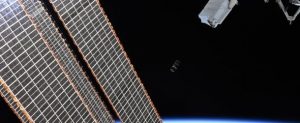Quantum News Briefs July 13: House of Representatives Passes H.R. 7535: ‘Quantum Computing Cybersecurity Preparedness Act’’, Speqtre Team Passes Milestone on Journey to Demo QKD from Space, IonQ Appoints Kathy Chou to Board of Directors, and MORE

Quantum News Briefs today begins with the passage of H.R. 7535 US House of Representatives “Quantum Computing Cybersecurity Preparedness Act’’with links to the official PDF text followed by the positive update that the international Speqtre team has passes an important milestone on journey to d emo QKD from space. We move back to earth with IonQ’s announcement that it has appointed Kathy Chou, SVP of SaaS Engineering at Nutanix, to the IonQ Board of Directors. And MORE.
House of Representatives Passes H.R. 7535: ‘Quantum Computing Cybersecurity Preparedness Act’’
 The House of Representatives on July 12 passed bill H.R. 7535 aimed at accelerating the government’s use of encryption algorithms that quantum computers would struggle to break with currently known methods, in part out of fear that an adversary might “steal sensitive encrypted data today using classical computers, and wait until sufficiently powerful quantum systems are available to decrypt it.”
The House of Representatives on July 12 passed bill H.R. 7535 aimed at accelerating the government’s use of encryption algorithms that quantum computers would struggle to break with currently known methods, in part out of fear that an adversary might “steal sensitive encrypted data today using classical computers, and wait until sufficiently powerful quantum systems are available to decrypt it.”
This Act may be cited as the ‘‘Quantum Computing Cybersecurity Preparedness Act’’. Review the text of H.R. 7535 is in PDF from by clicking here. The Bill is “To encourage the migration of Federal Government information technology systems to quantum-resistant cryptography, and for other purposes”.
SENSE OF CONGRESS.—It is the sense of Congress that— (1) a strategy for the migration of information technology systems of the Federal Government to post-quantum cryptography is needed; and (2) the Government wide and industry wide approach to post-quantum cryptography should prioritize developing applications, hardware intellectual property, and software that can be easily up dated to support cryptographic agility.
*****
IonQ Appoints Kathy Chou to Board of Directors

IonQ announced the appointment of Kathy Chou, SVP of SaaS Engineering at Nutanix, to the IonQ Board of Directors. As a member of the Board of Directors, Chou will help support IonQ’s work to build the world’s best quantum computers to solve the world’s most complex problems.
At Nutanix, Chou oversees a team responsible for the development, security and deployment of SaaS applications, systems and data assets across the entire Nutanix customer lifecycle. Chou joined Nutanix in January 2022 and previously served as the SVP of Worldwide Sales Strategy and Operations at VMware. Her tenure at VMWare spanned five years, touching multiple aspects of the customer success and engineering pipeline, including R&D, customer intelligence, and transforming VMware’s global customer operations function. She has also held multiple senior leadership positions at global enterprise tech companies like HP, Intuit, and Informatica.
A blog post further discussing Chou’s addition to the IonQ Board of Directors can be found here.
*****
Speqtre Team Passes Milestone on Journey to Demo QKD from Space
RAL Space’s Speqtre smallsat has passed a major milestone in its journey to space. The mission, which will demonstrate quantum key distribution (QKD) from space, has passed its critical design review (CDR) — the team can now build and test a full model of the satellite.
Speqtre is being developed by the Science and Technology Facilities Council’s RAL Space in the UK and SpeQtral, a quantum communications company in Singapore. The satellite platform is being designed and supplied by ISISPACE in the Netherlands.
In a radically different approach from traditional space missions, the Speqtre team are bringing together off-the-shelf products with brand new technology through an experimental development process. This will enable this state-of-the-art mission to get from the drawing board and into the orbit more quickly and at a lower cost than comparable missions.
*****
Quantum Computer Cools Itself by Performing Calculations
 A small diamond-based quantum computer developed by researchers at Germany’s University of Stuttgart performs a sequence of mathematical operations to cool itself.
A small diamond-based quantum computer developed by researchers at Germany’s University of Stuttgart performs a sequence of mathematical operations to cool itself.
The computer is comprised of three qubits in a diamond that is missing two carbon atoms, one replaced with a nitrogen atom and the other by a vacancy. The qubits were hit with microwaves, which altered the spin of either the nucleus of the nitrogen atom or the nuclei of the two carbon atoms near the vacancy.
The researchers said this algorithmic cooling was very close to the theoretical limit of maximum cooling efficiency.
*****
Sandra K. Helsel, Ph.D. has been researching and reporting on frontier technologies since 1990. She has her Ph.D. from the University of Arizona.




















